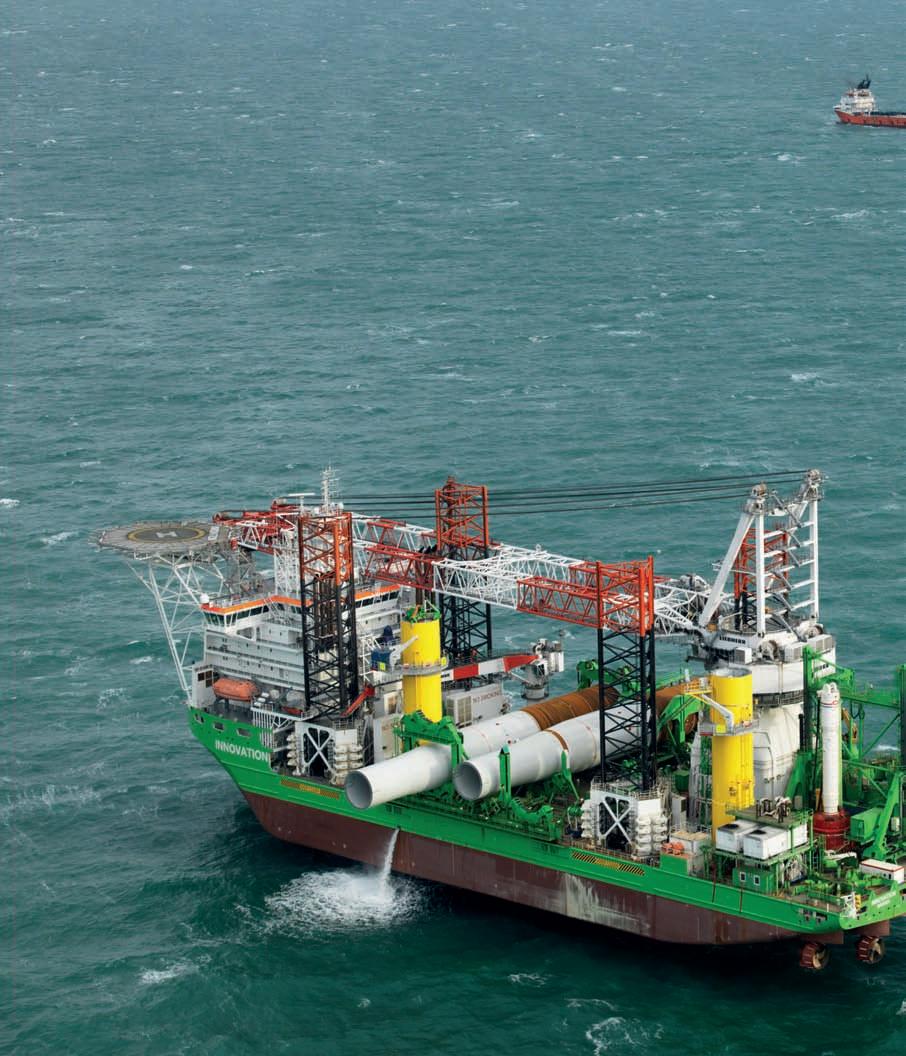
10 minute read
Borssele 1&2 well on track
DEME is installing a total of 94 monopiles, in depths varying from 14 to 40m.
THe DANiSH reNeWABLe eNergy DeVeLOPer ØrSTeD iS WOrkiNg HArD ON reALiSiNg iTS firST DuTCH OffSHOre WiNDfArM, BOrSSeLe 1&2. THe OPerATiONS & MAiNTeNANCe CeNTre fOr THe WiNDfArM WAS reCeNTLy iNAugurATeD, AND THe firST MONOPiLeS Were iNSTALLeD eArLier THiS yeAr.
All imAges COurTeSy Of ØrSTeD, uNLeSS STATeD OTHerWiSe.
The Borssele 1&2 offshore windfarm will be operated, monitored, and serviced from a newly constructed O&M centre in Vlissingen, the Netherlands. Once operational, it will be the first O&M centre in the Netherlands.
Self-reliant on power Construction of the base started in 2018 and concludes a total floor area of 2,100m 2 . This space will be used for offices, a workshop, and warehouse facilities. As a provider of renewable energy, Ørsted has put ample effort into making the centre as sustainable as possible. The building has solar panels. No natural gas will be used for heating the complex and residual heat from the servers will be used for heating the warehouse. High rate isolation material is used and shore power for the vessels will also come from solar panels. The entire facility will hence be completely self-reliant for power. Port Authority North Sea Port was responsible for the marine infrastructure and the realisation of the jetty, which will provide space for four vessels. Ørsted plans to standardly have two vessels ready for operation. Around 40 technicians will operate from the O&M base and their work will be facilitated by 10-20 office staff members, a vessel crew of 15-20 individuals, and a helicopter team. The technicians will in most cases be taken to the offshore windfarm by vessel. This will take only 90 minutes. Sometimes, for instance when wave conditions are bad, people will be transported by helicopter from Zeeland Airport, which is located only 10km from the O&M base. The trip to the windfarm will take fifteen minutes by helicopter.
Training technicians Steen Carsten Larsen is Head of Operations for the Borssele 1&2 Offshore Windfarm. He was closely involved in the realisation of the O&M base, as well as in the preparations for the start of the windfarm’s construction. Now that the O&M base is ready, this does >>
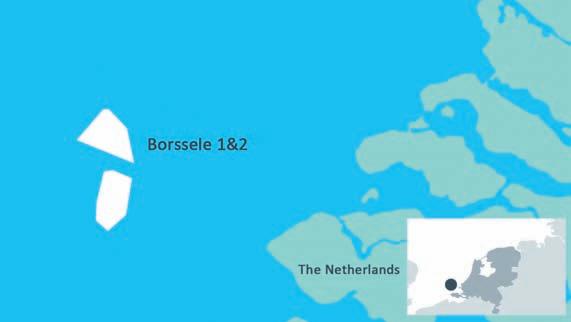
Borssele 1&2 is under construction 22km offshore from the coast of the southwestern province of Zeeland.
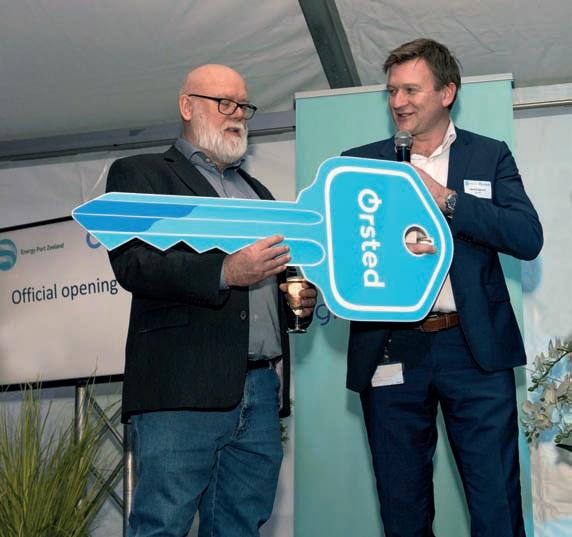
Ørsted is the world’s most sustainable company according to the global 100 ranking, which was announced in January. Having completed a fundamental business transformation from fossil fuels to renewables over the past decade, Ørsted urges all countries and companies to reduce their carbon emissions to help limit global warming to 1.5C. Ørsted outperformed more than 7,300 global companies with billiondollar revenues to rank #1 in Corporate knights’ 2020 index of the global 100 most sustainable corporations in the world. Ørsted becomes the first-ever energy company to top the index. Since 2006, the company has reduced carbon emissions from its energy generation and operations by 83%, and will be essentially carbon-neutral by 2025. Today, the offshore windfarms built by Ørsted bring green power to more than 13 million people, and Ørsted aims to grow this number to 50 million people by 2030. Ørsted’s ability to significantly grow its business, while substantially reducing its carbon emissions, has been central to attaining the top rank in the global 100 index.
Steen Carsten Larsen, Head of Operation for the Borssele 1&2 offshore windfarm at Ørsted (l), symbolically receives the key of the new O&M base from Henrik Egholm, EPC Director for Borssele 1&2 (r) at the inauguration of the O&M base in Vlissingen.
Blade fabrication. The rotor blades for the Borssele 1&2 windfarm will outsize a Jumbo 747-8 in length.
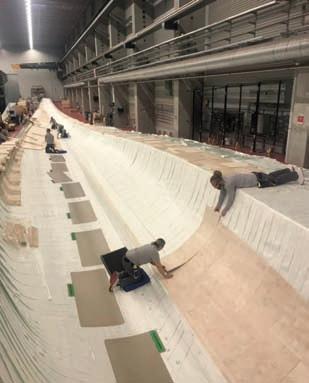
not mean that work for Mr Larsen and his team has now been put on hold until the first power is produced from the windfarm. “first of all, the construction of the windfarm will be partly managed and coordinated from our base”, he explains. “And of course, we already started to train the people for their future job on the Borssele windfarm. recruiting the people began in 2018, and we are now training the technicians at one of our existing offshore windfarms in uk and germany, so they will be ready for their job as soon as Borssele 1&2 becomes operational.” And according to Mr Larsen, there is a lot more to do. “We are currently preparing our base for the actual work, and we also help Siemens gamesa with their preparations, as they will also make use of our facilities. They will be responsible for maintenance in the first two operational years of the windfarm.”
End of this year in January of this year, Ørsted started constructing of Borssele 1&2 by installing the first foundations. Together with the opening of the new O&M base, this marked an important milestone for the project. Henrik egholm, ePC Director of Borssele 1&2, states, “it’s great that the installation has started now according to plan. We are very well on track with the construction of the windfarm. Borssele 1&2 will be operational by the end of this year.” Steven engels, Ørsted’s general Manager for the Netherlands at Ørsted, adds, “Borssele 1&2 will be our first offshore windfarm in the Netherlands and is an important step in the Dutch government’s ambitious shift towards green energy. Once completed, our windfarm will be the largest offshore windfarm in the Netherlands, able to supply renewable power to around one million Dutch households.” Borssele 1&2 is under construction 22km offshore from the coast of the southwestern province of Zeeland. DeMe is installing a total of 94 monopiles, in depths varying from 14m to 40m. The monopiles are produced by Sif, eeW, and Bladt industries. installation of the Siemens gamesa 8MW turbines will commence in April of this year.
Eight Eiffel Towers Most people involved in the offshore industry know that the offshore wind industry is an industry of large figures, especially as the turbines get bigger and
In Vlissingen, Ørsted realised the first O&M centre in the Netherlands., The 750MW Borssele 1&2 offshore windfarm will be operated, monitored, and serviced from this centre.
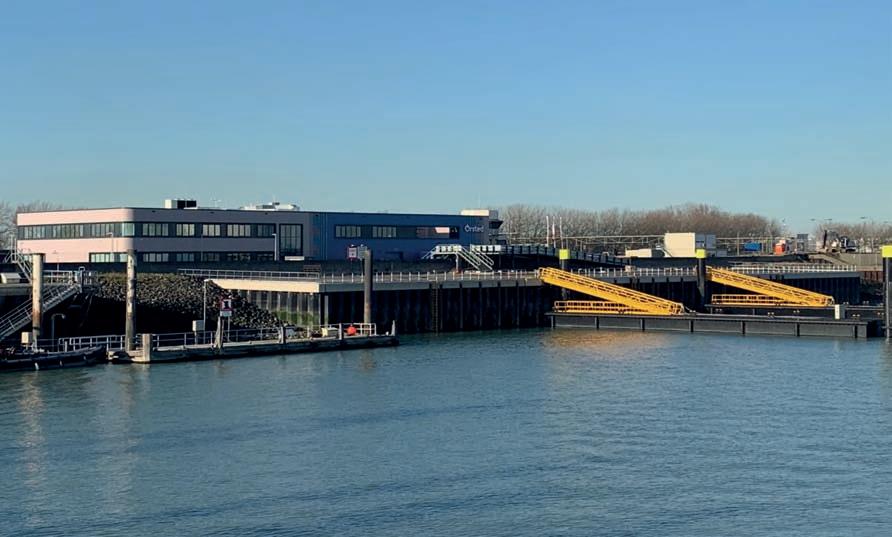
windfarms become larger. But how do the figures of, for example, Borssele 1&2 look when they are put in perspective? Mr Egholm made some comparisons during the opening event of Ørsted’s O&M base. “For Borssele 1&2, 94 monopiles are produced. Each monopile has a top diameter of 6m and a bottom diameter ranging from 7.8 to 8.5m. Altogether, the monopiles weigh around 80,000t. This equals eight times the weight of the Eiffel Tower in Paris.” Apart from the weight, the monopiles show another impressive figure when looking at the amount of steel used. As Mr Egholm explains, “If all steel plates used for the monopile cans are placed next to each other, they will cover 155,609m 2 . This equals a total of 23.5 football fields.”
London Eye After the installation of the monopiles, the transition pieces will be put in place on top of them. “For connecting the transition pieces to the monopiles,” Mr Egholm says, “11,092 large bolts are needed. Together, the bolts weigh approximately 204t, equivalent to the weight of 97 Audi Q7
Photo courtesy of Cordeel.
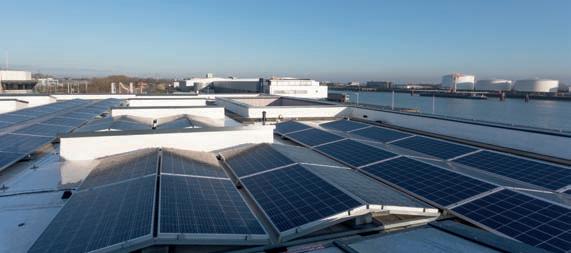
Ørsted has put ample effort into making the centre as sustainable as possible.
SUVs. Van Oord will install a total amount of 171km of array cables at the offshore windfarm. When placing all the cables behind one other, you would be able to cover the distance between Amsterdam and Antwerp.” According to Mr Egholm, the length of the rotor blades will be 81m. “This is longer than the length of a Boeing 747-8 (71m). The total wingspan of the WTG, including blades, will be 167m, which is
larger than the 135m wingspan of the London Eye.” The hours spent on the construction of the windfarm are impressive as well, or as Mr Egholm concludes, “Ørsted and contractors will spend approximately 2,000,000 working hours during the offshore construction phase. This is equivalent to 1,230 work years.”
2020: More offshore EPC spending
COMpEtItIVE pRICInG REMAInS thE nORM
SIGnIFICAnt COSt REDUCtIOnS hAVE IMpROVED E&p CAShFlOWS AnD ShOUlD DRIVE InCREASED OFFShORE tEnDERInG ACtIVIty In 2020. ACCORDInG tO WEStWOOD GlObAl EnERGy GROUp (WEStWOOD), pRICInG is expected to remain competitive, however, and contractors will need to remain focussed on profitability and avoid being locked into low-margin purgatory.
Oil markets are off to a rocky start in 2020, with heightened tensions in the Middle East, unprecedented Australian bushfires and the rise of the COVID-19 virus in China. For the offshore oil & gas sector, however, 2020 should be the second year of growth for an industry still reeling from the most severe downturn in its history. Westwood expects EUR 58 billion of contract awards for new offshore O&G production infrastructure (subsea production systems, SURF, pipelines, fixed platforms and floating production systems) in 2020 – a 49% increase over 2019 and the highest in seven years. A bumper year Floating production systems (FpS) spend is projected to reach EUR 18 billion in 2020 after hitting EUR 12.5 biilion last year. latin America will dominate activity with major awards such as Mero 3 (2Q), Itapu (4Q) and Sergipe (4Q) underpinning EUR 6.5 billion of spend. Africa will also feature with Woodside’s focus FpSO already awarded to MODEC in January and bp’s pAJ & Shell’s much anticipated bonga SW projects currently expected to be awarded late in the year. Other major awards anticipated are Western Gas’ Equus (Australia) and llOG’s Shenandoah (USA). Subsea tree contract awards underwhelmed in 2019 with only
Offshore EPC spending 2013-20 by contract award.

Source: Westwood – SubseaLogix & PlatformLogix. Artist impression courtesy of Woodside Energy.
212 tree orders, significantly lower than the 263 registered in 2018. Much of this can be attributed to a delay in award of certain key contracts such as payara (45 trees), Mamba (16 trees) and Sangomar (23 trees). With these major projects now expected this year, (Sangomar was awarded to the Subsea Integration Alliance of Subsea 7 and Schlumberger in early January), 2020 looks like a bumper year with 321 of projected tree awards and EUR 9.3 billion of subsea equipment order value for contractors.
Welcome reprieve Increasing orders are a welcome reprieve for a beleaguered offshore EpC supply chain
In January, MOCEC was awarded a contract for a FPSO by Woodside Energy for its Sangomar Field Development.
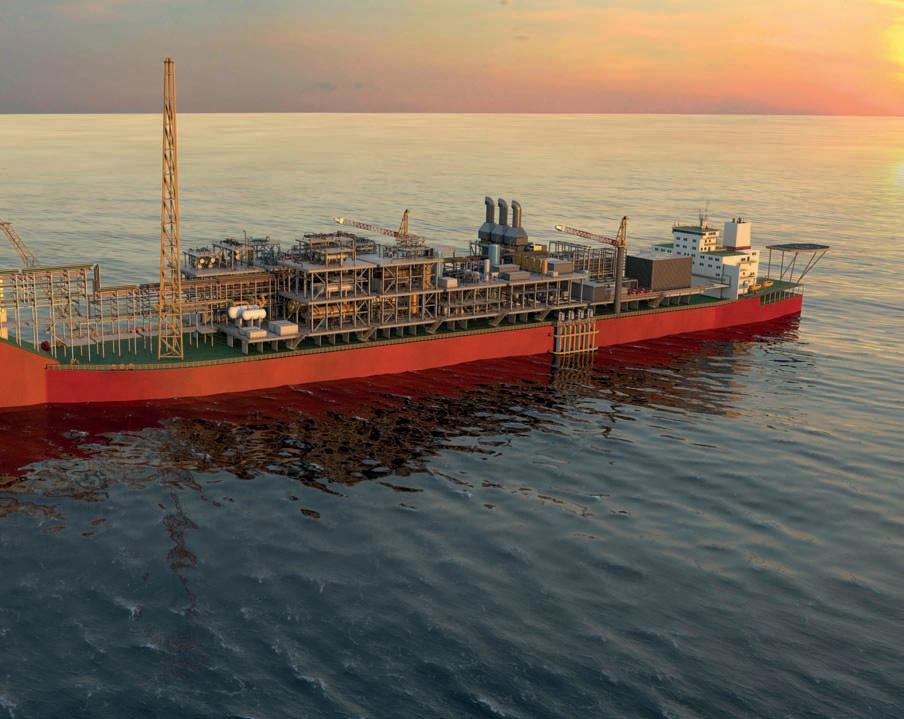
still reeling from the worst downturn in its history. In addition to fewer project sanctions, E&p customers have also driven down costs – drilling, field development and, ongoing production costs are all significantly lower relative to 2013/14 highs. the recovery remains fragile, however. With most E&ps budgets based on USD 60-65 per barrel, there is very little room for pricing growth, meaning contractors must continue to look within themselves to improve margins and profitability of their operations. this ‘new normal’ is already leading to delays in the rapidly recovering FpS sector, where order book growth for market leaders such as For the offshore oil & gas sector, 2020 should be the second year of growth for an industry still reeling from the most severe downturn in its history. MODEC & SbM is forcing E&ps to widen their search for EpCs that can deliver projects on time and on budget. If oil prices do continue to stick to their current USD 55-65 per barrel groove, contractors will more than ever need to clearly understand future tender activity and contracting dynamics. this will enable them to prioritize internal resources and stay right sized and relevant. Overall, 2020 is expected to see a jump in offshore E&p infrastructure tenders, as E&ps rush to lock in low costs. It looks like supply chain will have to hold its breath a while longer for relief from higher prices.










